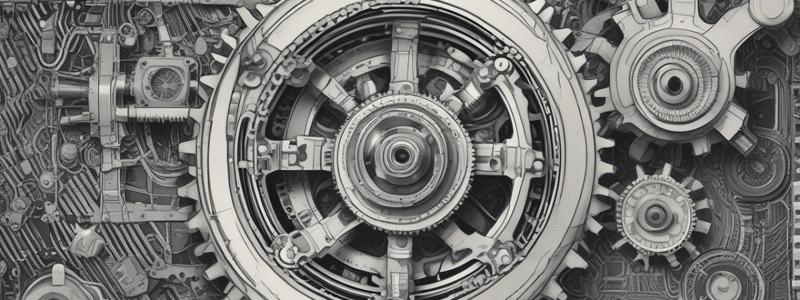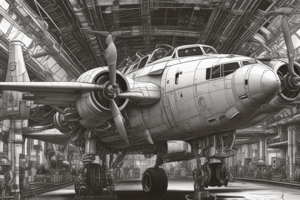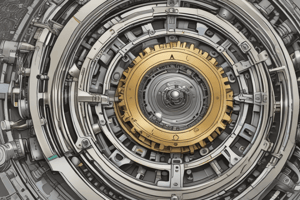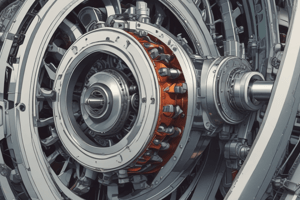Podcast
Questions and Answers
What is the primary function of the Parkinson Gear Tester?
What is the primary function of the Parkinson Gear Tester?
- To measure the angular differences of gears
- To measure the straightness of surfaces
- To record the radial variations of the gear
- To test the quality and accuracy of gears (correct)
What type of gears is the Parkinson Gear Tester mainly suitable for?
What type of gears is the Parkinson Gear Tester mainly suitable for?
- Helical gears and bevel gears
- All types of gears
- Worm gears and complex gear geometries
- Spur gears and simple gear profiles (correct)
What is a limitation of the Parkinson Gear Tester?
What is a limitation of the Parkinson Gear Tester?
- It is fully automated, requiring no human intervention
- It is manually operated, which can introduce human error (correct)
- It can test all types of gears accurately
- It is only used for high-volume production environments
What is an application of the Autocollimator?
What is an application of the Autocollimator?
What is the purpose of the spring pressure in the Parkinson Gear Tester?
What is the purpose of the spring pressure in the Parkinson Gear Tester?
What is recorded on the chart in the Parkinson Gear Tester?
What is recorded on the chart in the Parkinson Gear Tester?
What is a limitation of the Autocollimator?
What is a limitation of the Autocollimator?
What is a feature of the Parkinson Gear Tester?
What is a feature of the Parkinson Gear Tester?
What is the primary function of an optical dividing head?
What is the primary function of an optical dividing head?
Which component of an optical dividing head is used to select specific holes on the index plate?
Which component of an optical dividing head is used to select specific holes on the index plate?
What is the main advantage of using an optical dividing head?
What is the main advantage of using an optical dividing head?
What is the primary application of a toolmaker's microscope?
What is the primary application of a toolmaker's microscope?
What is the function of the micrometer head in a toolmaker's microscope?
What is the function of the micrometer head in a toolmaker's microscope?
Why is regular cleaning important for an optical dividing head?
Why is regular cleaning important for an optical dividing head?
What is the purpose of the sector arms in an optical dividing head?
What is the purpose of the sector arms in an optical dividing head?
What is the advantage of using a toolmaker's microscope in manufacturing and quality control?
What is the advantage of using a toolmaker's microscope in manufacturing and quality control?
What is the primary focus of gear measurement?
What is the primary focus of gear measurement?
What is the consequence of poorly machined gear teeth?
What is the consequence of poorly machined gear teeth?
What is the purpose of a standard roller in tooth space?
What is the purpose of a standard roller in tooth space?
What is the principle of the Parkinson Gear Tester?
What is the principle of the Parkinson Gear Tester?
What is the function of the spring pressure in the Parkinson Gear Tester?
What is the function of the spring pressure in the Parkinson Gear Tester?
What is the purpose of the dial indicator in the Parkinson Gear Tester?
What is the purpose of the dial indicator in the Parkinson Gear Tester?
What type of gears can be tested using the Parkinson Gear Tester?
What type of gears can be tested using the Parkinson Gear Tester?
What is the alternative to the dial indicator in the Parkinson Gear Tester?
What is the alternative to the dial indicator in the Parkinson Gear Tester?
What is the primary function of the stage in a toolmaker's microscope?
What is the primary function of the stage in a toolmaker's microscope?
What is the main advantage of a toolmaker's microscope?
What is the main advantage of a toolmaker's microscope?
What type of interferometer is commonly used for measuring small changes in distance or refractive index?
What type of interferometer is commonly used for measuring small changes in distance or refractive index?
What is the purpose of calibration in a toolmaker's microscope?
What is the purpose of calibration in a toolmaker's microscope?
What is the principle of interferometry?
What is the principle of interferometry?
What is the main application of a toolmaker's microscope in quality control?
What is the main application of a toolmaker's microscope in quality control?
What is the function of the coherent light source in interferometry?
What is the function of the coherent light source in interferometry?
What type of toolmaker's microscope is used for measuring micro-machined parts?
What type of toolmaker's microscope is used for measuring micro-machined parts?
What is the main application of the Sagnac Interferometer?
What is the main application of the Sagnac Interferometer?
What is an advantage of Interferometry?
What is an advantage of Interferometry?
What is a disadvantage of Interferometry?
What is a disadvantage of Interferometry?
What is the importance of surface texture in modern engineering products?
What is the importance of surface texture in modern engineering products?
What is a reason for controlling surface texture?
What is a reason for controlling surface texture?
What is measured in Fiber Optics using Interferometry?
What is measured in Fiber Optics using Interferometry?
What is a field of application where Interferometry is used?
What is a field of application where Interferometry is used?
What is required to maintain the accuracy of Interferometry measurements?
What is required to maintain the accuracy of Interferometry measurements?
Flashcards are hidden until you start studying
Study Notes
Gear Measurement
- Importance of paying attention to raw material, production cycle, machining, heat treatment, cutting, and surface finish of teeth for proper gear inspection
- Key dimensional accuracy checks: face width, bore, hub, length, and outside diameter
- Eccentricity and concentricity of blanks are crucial, and side faces should be true to the bore
- Additional measurements for precise gears: tip radius, shape of root, and surface finish
Good Alignment of Each Tooth
- Importance of even load distribution over the face of the gear
- Poor tooth alignment can lead to high bearing stresses and concentrated load on one edge
- Checking tooth alignment using a standard roller and surface plate
Parkinson Gear Tester
- Principle: measuring gear variations using a standard gear on a fixed spindle and the gear to be tested on a sliding carriage
- Movement of the sliding carriage indicates gear irregularities, which can be recorded using a dial indicator or a circular chart
- Used for testing spur gears
Limitations of Parkinson Gear Tester
- Limited to simple gear types (e.g., spur gears) and not suitable for complex gear geometries
- Manual operation may introduce human error
- Limited measurement range and accuracy limitations
- No advanced data recording and analysis capabilities
- Slow and labor-intensive process
- Subject to wear and tear, requiring regular calibration and maintenance
- Cost and maintenance concerns
- Single-purpose device
Autocollimator
- Optical instrument used for measuring small angular differences, changes, or deflections
- Principle: using a collimating lens to project parallel light beams and measure reflected light
- Applications:
- Measuring straightness and flatness of surfaces
- Precise angular indexing using polygons
- Comparative measurements using master angles
- Assessing squareness and parallelism of components
- Measuring small linear dimensions
Optical Dividing Head
- Precision tool used for accurately dividing a circle into equal parts
- Components:
- Base
- Spindle
- Index plate
- Sector arms
- Optical system
- Crank or handwheel
- Working principle:
- Mounting the workpiece
- Setting the angle using the index plate and sector arms
- Dividing the circle using the crank or handwheel
- Verifying the angle using the optical system
- Applications:
- Gear cutting
- Spline cutting
- Tool grinding
- Rotary table operations
- Advantages:
- High precision
- Versatility
- Repeatability
Tool Makers Microscope
- Highly precise optical instrument used for inspecting and measuring small parts, tools, and components
- Components:
- Optical system
- Stage
- Micrometer head
- Illumination
- Focusing mechanism
- Measurement scales
- Base
- Working principle:
- Placing the workpiece on the stage
- Adjusting the stage using micrometer heads
- Focusing the optical system
- Illuminating the workpiece
- Measuring dimensions using reticles or graduated scales
- Applications:
- Inspecting small parts
- Tool and die making
- Quality control
- Research and development
- Micro-machining
- Advantages:
- High precision
- Versatility
- Enhanced visibility
- Ease of use
- Durability
Interferometry
- Powerful technique for measuring small displacements, refractive index changes, surface irregularities, and other minute changes
- Basic principles:
- Interference of light waves
- Coherent light source
- Splitting and recombining light
- Types of interferometers:
- Michelson interferometer
- Fabry-Pérot interferometer
- Mach-Zehnder interferometer
- Sagnac interferometer
- Applications:
- Metrology
- Astronomy
- Fiber optics
- Material science
- Biology and medicine
- Advantages:
- High precision
- Non-contact measurement
- Versatility
- Disadvantages:
- Sensitivity to environmental factors
- Complex setup
- Cost
Surface Texture
- Importance of controlling surface texture in modern engineering products
- Influence of surface texture on:
- Appearance
- Corrosion resistance
- Wear resistance
- Fatigue resistance
- Lubrication
- Initial tolerance
- Load carrying capacity
- Noise reduction
- Reasons for controlling surface texture:
- Improving service life
- Reducing fatigue resistance
- Reducing initial wear
Studying That Suits You
Use AI to generate personalized quizzes and flashcards to suit your learning preferences.





